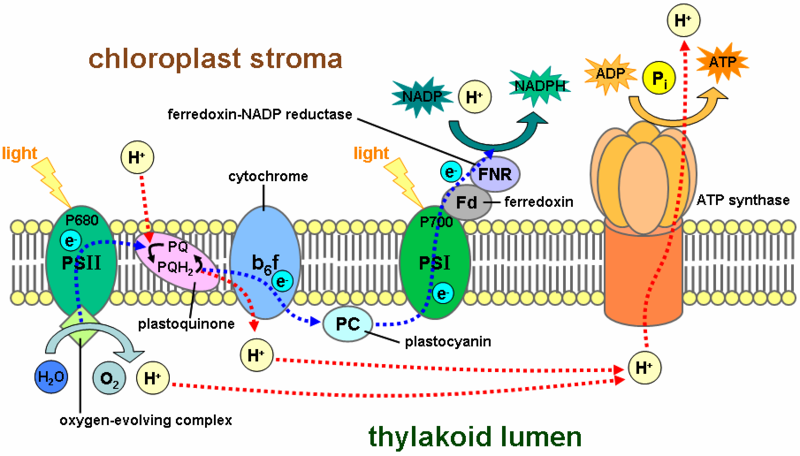

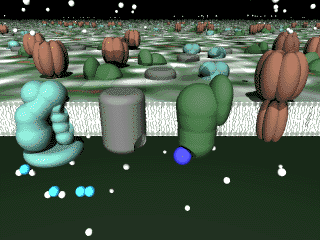
Figure 1: Photons hitting Photosystems II and I
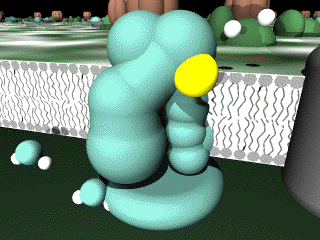
Figure 2: Photosystem II splitting water while plastoquinone (yellow) bonds with two excited electrons (white) from chlorophyll
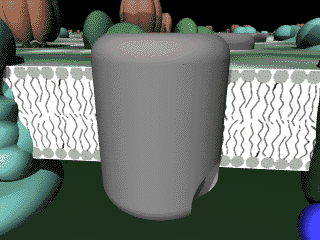
Figure 3: Cytochrome B6F

Figure 4: Photosystem I
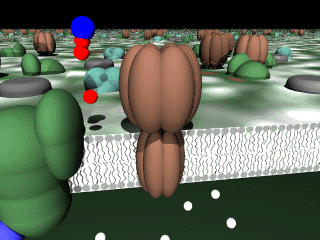
Figure 5: ATP Synthase creating ATP
First of all, you need to know some basic chemistry/physics . As you might remember, light has a peculiar property called wave-particle duality. This means that although usually light behaves as a wave, it also sometimes behaves as matter - stream of particles or little packets of energy that we call photons. This is how sunlight powers photosynthesis - the photosynthetic membranes and organelles are activated when hit by photons (light particles) of sunlight. Also, you might recall that electrons within an atom can absorb or emit photons in order to "jump" to or from a higher or lower energy level (energy shells). If an electron absorbs a photon, it jumps to a higher energy level. It can also emit the photon to jump back to a lower energy level. The bright colors you see in the flame when an element is being burned is actually all the photons (because they're light) being emitted as electrons jump back to the ground level, or lowest energy level possible.
Now let's take a look at the process. First, a photon hits the protein Photosystem II. Yes, Photosystem II comes before Photosystem I (they were named in the order they were discovered). The two photosystems involved in photoreduction are special structures known as light-harvesting complexes. They are composed of groups of special proteins. Each photosystem has a reaction center that contains a light-absorbing pigment molecule, usually chlorophyll, which is also responsible for the green color of plants. The reaction center of Photosystem II is called P680 because the maximum frequency of light it can absorb is 680 nanometers. When a photon hits a chlorophyll molecule in the reaction center of a photosystem complex, it excites an electron and makes it jump on to a nearby electron acceptor, plastoquinone. Plastoquinone accepts two high-energy electrons before bonding with two spare protons (aka hydrogen ions, or H+) to become plastoquinol. Plastoquinol carries the electrons to a proton pump, Cytochrome B6F, as a mobile electron carrier.
Meanawhile, you might have noticed that Photosystem II has a peculiar water-splitting complex at the bottom. This water-splitting complex is a highly evolved, poorly understood part of the Photosystem II, but very important. With this complex, the photosystem essentially "splits" water (H2O) into two electrons, two protons, and molecular oxygen, which is later released into the atmosphere. This is where most of our oxygen comes from. The two electrons go to the chlorophyll molecules in the reaction center to replace the ones that were used up in the reaction, and the protons stay in the thylakoid lumen, where they will later play an important role. This water-splitting process is the reason why all plants need water to photosynthesize. Figure 2 shows Photosystem II in close detail splitting water.
Plastoquinone, now plastoquinol (bonded with two extra electrons and protons), carries the electrons to the Cytochrome B6F Complex (Figure 3), which is a proton pump. Once there, the cytochrome removes the electrons and protons. Now there are four protons in the thylakoid lumen (two from plastoquinol and two from splitting water). Cytochrome B6F transfers the two electrons to yet another electron carrier, plastocyanin, and the cytochrome also pumps the four protons spare protons from the outside (chloroplast stroma) into the thylakoid lumen, creating a proton gradient (more protons on one side of the membrane than the other, which will be very important in the last step). Plastocyanin carries the electrons to Photosystem I.
As you might have seen in Figure 1, two photons actually hit Photosystems II and I at the same time. So while the electrons are being transferred from Photosystem II to plastoquinone/plastoquinol to Cytochrome B6F to plastocyanin to Photosystem I, Photosystem I is engaging in its own reaction when hit by a photon. Similarly to the reaction that occurs in Photosystem II, two electrons of some chlorophyll molecules in the reaction center of Photosystem I are excited and jump out. The reaction center of Photosystem I is called P700, because, as you might have guessed it, the maximum frequency of light it can absorb is 700 nanometers. The electrons are then taken in by a nearby electron acceptor. This time, the electron acceptor is an iron-sulfur protein known as ferredoxin. Ferredoxin then transfers the electrons to a nearby enzyme called ferredoxin-NADP reductase.
Ferredoxin-NADP reductase "attaches" the two electrons to NADP+ in the chloroplast stroma, making it NADPH. NADPH will later play an important role in the light-independent reactions. The two electrons from Photosystem II that were carried over by plastocyanin replace the ones used in Photosystem I. Meanawhile, Cytochrome Complex B6F, the proton pump from before, has been pumping protons into the thylakoid lumen. There is now a high concentration of protons inside the thylakoid lumen, and a shortage in the chloroplast stroma. Due to the natural process of diffusion, the protons "want" to go to the chloroplast stroma, but the membrane prevents them from crossing over. Instead, the protons flow through a very special enzyme called ATP Synthase, creating a protomotive force (the flow of protons through the ATP Synthase creates a force that "turns" the enzyme). ATP Synthase is considered by some to be the smallest mechanical motor in the world, turned by protons. In the process of turning, it binds a spare phosphate to ADP (adenosine diphosphate), creating ATP (adenosine triphosphate). As you might know, ATP is the "currency" of cells - kind of like money. It is an energy molecule that provides the cell with chemical energy for engaging in cellular activities. The whole point of the light-dependent reactions is to produce NADPH and ATP.
But where did the NADP+ and ADP and spare phosphate come from? It turns out they actually came from the light-independent reactions. Let's take a look...